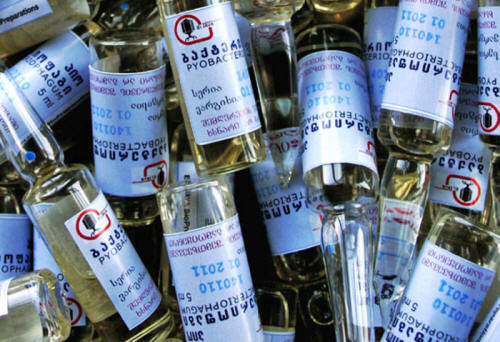|
from
Nature Website
for fighting
drug-resistant bacterial infections.
The rise of antibiotic resistance rekindles interest in
a century-old virus treatment.
Phage therapy is still widely used in Russia, Georgia and Poland, but never took off elsewhere.
Now, faced with the looming spectre of antibiotic resistance, Western researchers and governments are giving phages a serious look.
In March, the US National Institute of Allergy and Infectious Diseases listed phage therapy as one of seven prongs in its plan to combat antibiotic resistance.
And at the American Society for Microbiology (ASM) meeting in Boston last month, Grégory Resch of the University of Lausanne in Switzerland presented plans for Phagoburn:
Ryland Young, a virologist at Texas A&M University in College Station, attributes the previous lack of Western interest to clinicians' preference for treating unknown infections with broad-spectrum antibiotics that kill many types of bacterium.
Phages, by contrast, kill just one species or strain.
But researchers now realize that they need more precise ways to target pathogenic bacteria, says microbiologist Michael Schmidt of the Medical University of South Carolina in Charleston.
Along with the rising tide of strains resistant to last-resort antibiotics, there is growing appreciation that wiping out the human body's beneficial microbes along with disease-causing ones can create a niche in which antibiotic-resistant bacteria can thrive.
Finding a phage for a bacterial target is relatively easy, Young says.
Nature provides an almost inexhaustible supply: no two identical phages have ever been found. As a bacterium becomes resistant to one phage - by shedding the receptor on the cell surface that the virus uses to enter - the Eliava Institute researchers simply add more phages to the viral cocktails that patients receive.
Mzia Kutateladze says that they
update their products every eight months or so, and do not always
know the exact combination of phages that make up the cocktail.
He hopes that phage therapy will be
treated in a similar way to the seasonal influenza vaccine, for
instance, which is updated every year as new flu strains emerge.
The patients will be given phage preparations from a company in Romainville, France, called Pherecydes Pharma, which has isolated more than 1,000 viruses from sources such as sewage or river water and screened them for the ability to kill pathogenic bacteria.
To lower the chance that resistance will
develop, the patients will receive a cocktail of more than a dozen
phages that enter bacterial cells in different ways. If the phage
treatment fails, patients will then receive standard antibiotics.
Because phage therapy is nearly a century old, it would be difficult for a company to claim a treatment as intellectual property, and therefore recoup its costs. Young says it is likely that a 2013 ruling by the US Supreme Court against the patenting of natural genes would also apply to phages isolated from nature.
Jérôme Gabard, chief executive of
Pherecydes, says that the company is banking on hopes that
developing and characterizing precise combinations of natural phages
to target particular bacteria will be patentable.
The phage injects the bacterium with
DNA, which the microbe transcribes into RNA. If part of the
bacterium's antibiotic-resistance gene matches that RNA sequence, an
enzyme called
Cas9 cuts up the cell's DNA,
killing it.
Giving the phage to wax-worm larvae
infected with resistant E. coli increased the worms' chance of
survival. The researchers are now starting to test the system in
mice (human trials are a long way off).
Kutateladze says that an increasing number of EU patients are travelling to Georgia for phage treatment.
She adds that doctors in some EU countries send patients' samples to the Eliava Institute, which then sends back a phage cocktail specific to the bacterium causing the infection.
Meanwhile, researchers are watching the Phagoburn study with interest, hoping that it will lay the groundwork for moving the technology into the clinic.
It should have said that the phage injects DNA into the bacterium, which then transcribes it into RNA. If part of the bacterium's antibiotic-resistance gene matches that RNA sequence, Cas9 cuts up the cell's DNA.
The text has now been corrected.
|


